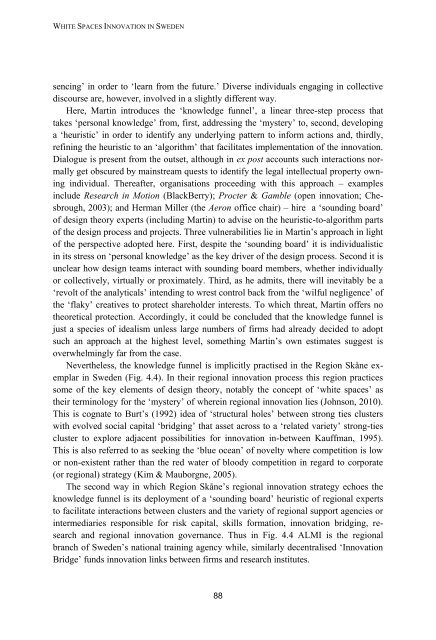White Spaces Innovation in Sweden - Innovation policy for ... - Vinnova
White Spaces Innovation in Sweden - Innovation policy for ... - Vinnova
White Spaces Innovation in Sweden - Innovation policy for ... - Vinnova
You also want an ePaper? Increase the reach of your titles
YUMPU automatically turns print PDFs into web optimized ePapers that Google loves.
WHITE SPACES INNOVATION IN SWEDENsenc<strong>in</strong>g‟ <strong>in</strong> order to „learn from the future.‟ Diverse <strong>in</strong>dividuals engag<strong>in</strong>g <strong>in</strong> collectivediscourse are, however, <strong>in</strong>volved <strong>in</strong> a slightly different way.Here, Mart<strong>in</strong> <strong>in</strong>troduces the „knowledge funnel‟, a l<strong>in</strong>ear three-step process thattakes „personal knowledge‟ from, first, address<strong>in</strong>g the „mystery‟ to, second, develop<strong>in</strong>ga „heuristic‟ <strong>in</strong> order to identify any underly<strong>in</strong>g pattern to <strong>in</strong><strong>for</strong>m actions and, thirdly,ref<strong>in</strong><strong>in</strong>g the heuristic to an „algorithm‟ that facilitates implementation of the <strong>in</strong>novation.Dialogue is present from the outset, although <strong>in</strong> ex post accounts such <strong>in</strong>teractions normallyget obscured by ma<strong>in</strong>stream quests to identify the legal <strong>in</strong>tellectual property own<strong>in</strong>g<strong>in</strong>dividual. Thereafter, organisations proceed<strong>in</strong>g with this approach – examples<strong>in</strong>clude Research <strong>in</strong> Motion (BlackBerry); Procter & Gamble (open <strong>in</strong>novation; Chesbrough,2003); and Herman Miller (the Aeron office chair) – hire a „sound<strong>in</strong>g board‟of design theory experts (<strong>in</strong>clud<strong>in</strong>g Mart<strong>in</strong>) to advise on the heuristic-to-algorithm partsof the design process and projects. Three vulnerabilities lie <strong>in</strong> Mart<strong>in</strong>‟s approach <strong>in</strong> lightof the perspective adopted here. First, despite the „sound<strong>in</strong>g board‟ it is <strong>in</strong>dividualistic<strong>in</strong> its stress on „personal knowledge‟ as the key driver of the design process. Second it isunclear how design teams <strong>in</strong>teract with sound<strong>in</strong>g board members, whether <strong>in</strong>dividuallyor collectively, virtually or proximately. Third, as he admits, there will <strong>in</strong>evitably be a„revolt of the analyticals‟ <strong>in</strong>tend<strong>in</strong>g to wrest control back from the „wilful negligence‟ ofthe „flaky‟ creatives to protect shareholder <strong>in</strong>terests. To which threat, Mart<strong>in</strong> offers notheoretical protection. Accord<strong>in</strong>gly, it could be concluded that the knowledge funnel isjust a species of idealism unless large numbers of firms had already decided to adoptsuch an approach at the highest level, someth<strong>in</strong>g Mart<strong>in</strong>‟s own estimates suggest isoverwhelm<strong>in</strong>gly far from the case.Nevertheless, the knowledge funnel is implicitly practised <strong>in</strong> the Region Skåne exemplar<strong>in</strong> <strong>Sweden</strong> (Fig. 4.4). In their regional <strong>in</strong>novation process this region practicessome of the key elements of design theory, notably the concept of „white spaces‟ astheir term<strong>in</strong>ology <strong>for</strong> the „mystery‟ of where<strong>in</strong> regional <strong>in</strong>novation lies (Johnson, 2010).This is cognate to Burt‟s (1992) idea of „structural holes‟ between strong ties clusterswith evolved social capital „bridg<strong>in</strong>g‟ that asset across to a „related variety‟ strong-tiescluster to explore adjacent possibilities <strong>for</strong> <strong>in</strong>novation <strong>in</strong>-between Kauffman, 1995).This is also referred to as seek<strong>in</strong>g the „blue ocean‟ of novelty where competition is lowor non-existent rather than the red water of bloody competition <strong>in</strong> regard to corporate(or regional) strategy (Kim & Mauborgne, 2005).The second way <strong>in</strong> which Region Skåne‟s regional <strong>in</strong>novation strategy echoes theknowledge funnel is its deployment of a „sound<strong>in</strong>g board‟ heuristic of regional expertsto facilitate <strong>in</strong>teractions between clusters and the variety of regional support agencies or<strong>in</strong>termediaries responsible <strong>for</strong> risk capital, skills <strong>for</strong>mation, <strong>in</strong>novation bridg<strong>in</strong>g, researchand regional <strong>in</strong>novation governance. Thus <strong>in</strong> Fig. 4.4 ALMI is the regionalbranch of <strong>Sweden</strong>‟s national tra<strong>in</strong><strong>in</strong>g agency while, similarly decentralised „<strong>Innovation</strong>Bridge‟ funds <strong>in</strong>novation l<strong>in</strong>ks between firms and research <strong>in</strong>stitutes.88
















